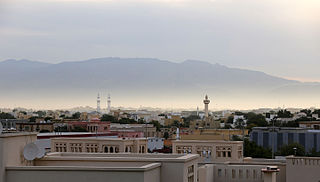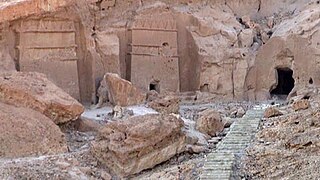
Yemen is located in Southwest Asia, at the southern tip of the Arabian Peninsula, between Oman and Saudi Arabia. It is situated at the entrance to the Bab-el-Mandeb Strait, which links the Red Sea to the Indian Ocean and is one of the most active and strategic shipping lanes in the world. Yemen has an area of 527,970 square kilometres (203,850 sq mi), including the islands of Perim at the southern end of the Red Sea and Socotra at the entrance to the Gulf of Aden. Yemen's land boundaries total 1,746 kilometres (1,085 mi). Yemen borders Saudi Arabia to the north and Oman to the northeast.

Mount Sinai, also known as Mount Horeb or Gabal Musa, is a mountain in the Sinai Peninsula of Egypt that is a possible location of the biblical Mount Sinai, which is considered a holy site by the Abrahamic religions. Mount Sinai is mentioned many times in the Book of Exodus and other books of the Bible, and the Quran. According to Jewish, Christian, and Islamic tradition, the biblical Mount Sinai was the place where Moses received the Ten Commandments.

Mount Nebo is an elevated ridge in Jordan, approximately 710 metres (2,330 ft) above sea level, mentioned in the Hebrew Bible as the place where Moses was granted a view of the Promised Land. The view from the summit provides a panorama of the Holy Land and, to the north, a more limited one of the valley of the River Jordan. The West Bank city of Jericho is usually visible from the summit, as is Jerusalem on a very clear day.

Taiz is a city in southwestern Yemen. It is located in the Yemeni Highlands, near the port city of Mocha on the Red Sea, lying at an elevation of about 1,400 metres (4,600 ft) above sea level. It is the capital of Taiz Governorate. With a population of over 600,000 in 2005, it is the third largest city in Yemen after the capital Sana'a and the southern port city of Aden. Taiz is considered to be the cultural capital of Yemen.

Mount Arafat or Mount Arafah is a granite hill about 20 km (12 mi) east of central Mecca in the plain of Arafat. Mount Arafat reaches about 70 m (230 ft) in height and is also known as the "Mount of Mercy". According to Islamic tradition, the hill is the place where the Prophet Muhammed stood and delivered the Farewell Sermon to the Muslims who had accompanied him for the Hajj towards the end of his life. Muslims also say that it is also the place where Adam and Hawa reunited on earth after falling from Heaven. It is the place where Adam was forgiven, hence it is also known as the "Mount of Mercy". A pillar is erected to show the place where the aforementioned took place.

Jabal an-Nour is a mountain near Mecca in the Hejazi region of Saudi Arabia. The mountain houses the famed Grotto/Cave of Hira. The mountain and its cave hold tremendous significance for Muslims throughout the world, as the Islamic Nabī (Prophet) Muhammad is said to have spent a great deal of time in the cave meditating, and it is widely believed that it was here that he received his first revelation, which consisted of the first five ayats of Surah Al-Alaq from the archangel Jibrā’īl. It is one of the most popular tourist attractions in Makkah. The mountain itself is barely 640 m (2,100 ft) tall; nonetheless one to two hours are needed to make the strenuous hike to the cave. Its 1750 steps to the top, which can take anywhere between 25minutes to 1hr 30 minutes.

Jabal Al-Mebraḥ, also known as Jabal Yibir, is a 1,727 m (5,666 ft) tall mountain in the United Arab Emirates (UAE). It is located in the Western Hajar Mountains near 25°38′54″N56°7′45″E. Jebel Al Mebrah has a prominence of around 300 m (980 ft) from its parent peak, Jebel Qihwi, which is on the other side of the border in Musandam Governorate, Oman. The highest point in the UAE is Jebel Jais near Ras al-Khaimah at about 1,910 m (6,270 ft), however, its summit is also in Musandam Governorate in Oman, meaning that whereas Jabal Jais has the highest point in the UAE, the highest peak in the UAE is that of Jabal Yibir.

Jabal al-Lawz, also known as Gebel el-Lawz, is a mountain located in northwest Saudi Arabia, near the Jordanian border, above the Gulf of Aqaba at 2,580 metres above sea level. The name means 'mountain of almonds'. The peak of Jabal al-Lawz, consists of a light-colored, calc-alkaline granite that is intruded by rhyolite and andesite dikes which generally trend eastward.

Jebel ech Chambi is a mountain peak in Tunisia. It sits at an elevation of 1544m, the highest summit in the territory. The mountain stands above the city of Kasserine in western central Tunisia. It is covered by a pine forest and surrounded by Chaambi National Park.

Jabal Thawr is the name of a mountain in Saudi Arabia, located in the lower part of Mecca to the south of the district of Misfalah. Height of the mountain is 1,405 m (4,610 ft).

Jebel Shams is a mountain located in northeastern Oman north of Al Hamra town. It is the highest mountain of the Hajar range and the country, and the third highest in Arabian Peninsula. The mountain is a popular sightseeing area located 240 km (150 mi) from Muscat. In the summer, temperature is around 20 °C (68 °F)) and in the winter it drops to less than 0 °C (32 °F). Nearby is Jabal Akhdar, another prominent peak in the region.

Jabal al-Tair Island is a roughly oval volcanic island in Yemen, northwest of the constricted Bab al-Mandab passage at the mouth of the Red Sea, about halfway between mainland Yemen and Eritrea. From 1996 until it erupted in 2007, Yemen maintained two watchtowers and a small military base on the island.

Jabal Sawda is a peak located in Saudi Arabia, with an elevation of around 3,000 metres (9,843 ft).

Al-Hajar Mountains in northeastern Oman and also the eastern United Arab Emirates are the highest mountain range in the eastern Arabian peninsula. Also known as "Oman Mountains", they separate the low coastal plain of Oman from the high desert plateau, and lie 50–100 km (31–62 mi) inland from the Gulf of Oman.

Jabal Mareer is a mountain of the Sarwat Mountains in the Arabian Peninsula and is located in the village of Al Qahtan about 15 kilometers north of Al-Namas in the Asir region.

Jabal Al-Majāz is a mountain in the Sarawat range, 'Asir Region of Saudi Arabia, near the Yemeni border. At 2,902 m (9,521 ft) in height, it is one of the tallest mountains in the Saudi Kingdom.
Jabal Al-Qo'mah is a mountain of Saudi Arabia. The mountain is 2,707 high and located at 17°51′50″N 43°25′25″e.





















